Albania Part dy (Tirana & Berat)
I’m generally not the biggest fan of capital cities. I don’t know how many times I’ve heard “Why didn’t you stay longer in Paris, or go to Rome, or Madrid, or Rabat”, etc etc. Often I just make excuses but the truth is I’m generally more attracted to small regional places. There’s a reason I didn’t continue to live most of my adult life in Sydney where I was born and bred. Still, I did go to Tirana, catching the early morning bus from Bajram Curri, travelling across the border to Kosovo and back again to arrive in the capital sometime after midday.
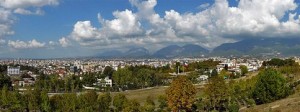 Becca and I jumped off the bus somewhere near where we thought we were supposed to go and started walking along the boulevard amongst larger hotels and embassy buildings. What we didn’t realize was that the hostel had moved sometime in the past year or so; luckily for us a friendly taxi driver knew and offered to take us down the road a few minutes for free. Tick number two for Albanian hospitality. Ilir met us at the gates and ushered us in to Tirana backpackers, a cozy little place that also functioned as a cafe popular with many of the natives.
Becca and I jumped off the bus somewhere near where we thought we were supposed to go and started walking along the boulevard amongst larger hotels and embassy buildings. What we didn’t realize was that the hostel had moved sometime in the past year or so; luckily for us a friendly taxi driver knew and offered to take us down the road a few minutes for free. Tick number two for Albanian hospitality. Ilir met us at the gates and ushered us in to Tirana backpackers, a cozy little place that also functioned as a cafe popular with many of the natives.
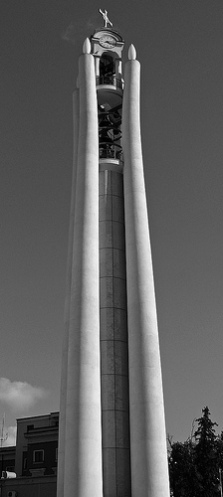 What to say about Tirana? It’s a four hundred or so year old city founded by the Ottomans. It’s one of the earliest areas in Albania to be settled and subsequently hosts many old Illyrian names in and around its suburbs. It has a great National Historical Museum fronted by an impressive large mosaic entitled ‘The Albanians’. Being somewhat into history in places I visit this museum was the first place on my list of sites to visit, and well worth it. It includes information and artefacts dating back to the 6th century BC, the time of the Illyrians, and gives a good general overview of the long and churning history of Albania itself. A must for every visitor to the city in my opinion, even though many items were apparently looted in the ‘wild 90’s‘. A minute or two away from the museum in Skanderbeg square is the great statue of Skanderbeg himself, one of the chief figures and obvious heroes in Albania’s emancipation from the Turkish Ottomans. Having fought for them for twenty years, Skanderbeg subsequently turned his energies to founding the League of Lezhë and uniting Albanian principalities against them.
What to say about Tirana? It’s a four hundred or so year old city founded by the Ottomans. It’s one of the earliest areas in Albania to be settled and subsequently hosts many old Illyrian names in and around its suburbs. It has a great National Historical Museum fronted by an impressive large mosaic entitled ‘The Albanians’. Being somewhat into history in places I visit this museum was the first place on my list of sites to visit, and well worth it. It includes information and artefacts dating back to the 6th century BC, the time of the Illyrians, and gives a good general overview of the long and churning history of Albania itself. A must for every visitor to the city in my opinion, even though many items were apparently looted in the ‘wild 90’s‘. A minute or two away from the museum in Skanderbeg square is the great statue of Skanderbeg himself, one of the chief figures and obvious heroes in Albania’s emancipation from the Turkish Ottomans. Having fought for them for twenty years, Skanderbeg subsequently turned his energies to founding the League of Lezhë and uniting Albanian principalities against them.
Other city sites that I visited and are worthy of a look include Et’hem Bey Mosque, the Tanners’ Bridge, the old Clock Tower, the Big Park of Tirana, Varrezat e Dëshmorëve (the Martyr’s cemetery – great view down on the city), the new modern Orthodox Cathedral (that some liken to a nuclear power plant) and the equally bizarre Tirana pyramid, once known as the Enver Hoxha Museum (or Mausoleum). Since Albania’s break from Communism it’s played house to an international cultural centre, a cafe as well as the US Agency for international development. Apparently it’s destined to be pulled down, though there still appears to be much heated discussion about its future. The plan for it to be demolished and replaced by a parliamentary complex in time for the 100th anniversary of Albania’s independence obviously didn’t come to pass.
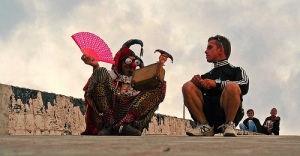 I spent one pleasant and curious afternoon with ol’ mate Jolly Goodfellow, otherwise known as Rumple the Jester, an Australian performance artist I knew of from the old days of the mid 1990’s. As designated photographer I followed Rumple around the streets of Tirana snapping off shots of him posing in front of fruit stalls, with Roma kids, climbing the above mentioned Pyramid and of course trying to earn an Albanian lek or two by juggling, to the delight of many young kids and families (though some did look confused as to what such a strange character was doing in their little part of the world). Actually that afternoon was one of the highlights of my time in Tirana. Another was having a night or two when the hostel played host to random concerts by wayfaring and local musicians (and big jugs of raki all round!).
I spent one pleasant and curious afternoon with ol’ mate Jolly Goodfellow, otherwise known as Rumple the Jester, an Australian performance artist I knew of from the old days of the mid 1990’s. As designated photographer I followed Rumple around the streets of Tirana snapping off shots of him posing in front of fruit stalls, with Roma kids, climbing the above mentioned Pyramid and of course trying to earn an Albanian lek or two by juggling, to the delight of many young kids and families (though some did look confused as to what such a strange character was doing in their little part of the world). Actually that afternoon was one of the highlights of my time in Tirana. Another was having a night or two when the hostel played host to random concerts by wayfaring and local musicians (and big jugs of raki all round!).
Tirana is a nice city to visit, not too big or crazy, with friendly locals, a really cool green-zone within walking distance of the centre and half a dozen different bus stations (some are just intersection corners) servicing different regions of the country and abroad. Just ask some locals where to go and you’ll be right mate! As usual though, it wasn’t my favorite part of the country.
Hello Berat.
 I located the bus station that serviced Berat and wandered a few minutes down the road from the hostel to find the next bus leaving in 15 minutes. Perfect. A couple of hours later, after going in what seemed haphazard directions first west toward the coast, down, inland and back up I was dropped off at the old bridge near the centre of town, crossed the Osum river and walked up the hill to Berat Backpackers in the old district of Gorica.
I located the bus station that serviced Berat and wandered a few minutes down the road from the hostel to find the next bus leaving in 15 minutes. Perfect. A couple of hours later, after going in what seemed haphazard directions first west toward the coast, down, inland and back up I was dropped off at the old bridge near the centre of town, crossed the Osum river and walked up the hill to Berat Backpackers in the old district of Gorica.
With respect to the roundabout bus route, I was later told a funny story by a local about the way in which public transport functions in Albania. It’s somewhat of a joke I guess with a certain amount of truth. People jest that every bus in Albania must first drive in the opposite direction from its destination, then loop around and slowly meander back towards where it is supposed to be going. When it is close, it keeps on going, past where the crow would turn left or right for home, making sure to go at least another half hour out of its way before finally turning around again and reaching its goal. The truth behind this joke likely lies in its reflection of the way the roads have been built, crisscrossing the country in a strange network of higgledy piggledy paths, sometimes paved and often potholed. Having said that, the bus drivers mostly seemed good natured and patient in their approach. Visitors do well in adopting a similar strategy.
Anyway, to Berat. Berat is a small old Ottoman city south of Tirana, one of if not the best preserved of Ottoman towns in the Balkans. Alongside Gjirokastër it is one of Albania’s ‘museum towns’. I’d visited a number of areas in the Balkans that the Ottomans had ruled over for close to 500 years but never seen whole districts preserved as well as in Berati. The Gorica district as well as that of Mangalem are rife with old Ottoman buildings and the local Ethnographic Museum is housed in a well preserved traditional dwelling from the 18th century. The building itself is as interesting as the exhibits inside and I couldn’t help but imagine myself sitting cross legged on the small raised corner of the verandah reserved for tea drinking and discussions of the day’s events.
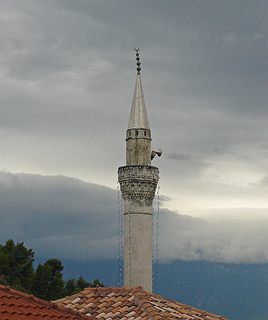 I spent some days walking around different districts in Berat, hiking up to the old citadel and bush-bashing back down, visiting the old Roman ruins above the hostel in Gorica and doing what all worthy Albanians do, walking the Giro. The Giro is a national pastime of sorts where everybody comes out to stroll up and down one of the main boulevards in most towns; taking time to talk, relax, sit and enjoy a coffee in the late afternoon light. The road is blocked off from motorized traffic for a couple of hours becoming a slow motion pedestrian highway.
I spent some days walking around different districts in Berat, hiking up to the old citadel and bush-bashing back down, visiting the old Roman ruins above the hostel in Gorica and doing what all worthy Albanians do, walking the Giro. The Giro is a national pastime of sorts where everybody comes out to stroll up and down one of the main boulevards in most towns; taking time to talk, relax, sit and enjoy a coffee in the late afternoon light. The road is blocked off from motorized traffic for a couple of hours becoming a slow motion pedestrian highway.
Another thing I stumbled upon in Berat was the world of the Ottoman Han, old inns traditionally catering for traveling tradesmen and the like selling their wares in the old bazaars of towns (they were prominent throughout the Balkans and as far east as Central Asia). It was a place for them to do business, look after their horses (many included stables), eat sleep and potentially get up to no good whilst away from their wives. The Han in Berat is located within a small compound that also includes the King Mosque and Halveti Tekke (Teqeja e Helvetive), a Dervish lodge belonging to the Khalwati order of Sufi’s. Tekke’s are an interesting phenomenon in themselves, a counterpart to the more orthodox Madrassa, hospices for Sufi travellers and much more. Many Tekke’s in the Balkans belong to the Bektashi order, another Sufi order with its roots in 13th century Persia. Yes the world moves about doesn’t it. But more on this later.
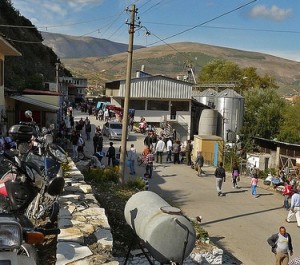 One other highlight of my time in Berat was the weekly gypsy markets where is everything is up for grabs at ridiculously low prices. Having a backpack that already weighs 15 or so kilograms I wasn’t that keen to increase the breadth of my belongings so just wandered through. Had I been keen to buy I could have picked up a few kilograms of cheap tobacco, complete stylish Adidas tracksuits for a few euros, chickens, eggs, shoes, socks, turkeys, stirrups, donkeys, knives, jewellery, belts, soccer balls, wigs, cheese, raki, fruit, vegetables, sweets and most everything else you could care to name. The only thing that didn’t seem to be for sale were smiles and friendly chatter which were given away for free.
One other highlight of my time in Berat was the weekly gypsy markets where is everything is up for grabs at ridiculously low prices. Having a backpack that already weighs 15 or so kilograms I wasn’t that keen to increase the breadth of my belongings so just wandered through. Had I been keen to buy I could have picked up a few kilograms of cheap tobacco, complete stylish Adidas tracksuits for a few euros, chickens, eggs, shoes, socks, turkeys, stirrups, donkeys, knives, jewellery, belts, soccer balls, wigs, cheese, raki, fruit, vegetables, sweets and most everything else you could care to name. The only thing that didn’t seem to be for sale were smiles and friendly chatter which were given away for free.
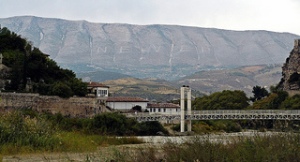 Last but not least I should mention something that I actually didn’t see for a few days and couldn’t believe that I’d missed when I did. Looking to the north of the town I noticed the word NEVER carved into the hills. I assumed this must be some play on the word Enver and asked Scottie from the hostel if he knew anything more. He told me that during Enver Hoxha’s time, the dictator had carved his name, in huge letters, into the hill to reinforce the idea of his omnipresence to the people, or some such thing. Apparently this happened in a number of towns, though I’m unsure about the truth of that. In any case, from what I heard, one day not so many years ago the newly fashioned anagram appeared suddenly out of nowhere, mown into the high ground by a farmer and his son, perhaps to remind the population of, well, I hardly need to say.
Last but not least I should mention something that I actually didn’t see for a few days and couldn’t believe that I’d missed when I did. Looking to the north of the town I noticed the word NEVER carved into the hills. I assumed this must be some play on the word Enver and asked Scottie from the hostel if he knew anything more. He told me that during Enver Hoxha’s time, the dictator had carved his name, in huge letters, into the hill to reinforce the idea of his omnipresence to the people, or some such thing. Apparently this happened in a number of towns, though I’m unsure about the truth of that. In any case, from what I heard, one day not so many years ago the newly fashioned anagram appeared suddenly out of nowhere, mown into the high ground by a farmer and his son, perhaps to remind the population of, well, I hardly need to say.
If you have the chance, pay a visit to little Berat for a few days sometime and step back into some fascinating aspects of an older world.
Anyway that’s enough history and serious business for now, time to head further south and cleanse the head with a dip or two in the Ionian sea.
To be continued….
Out of Europe? No wait, it’s Albania. Part një
The North (Tivat-Skhodra, Komani ferry, Valbona & Thethi)
I’d been thinking about going to Albania for a while, having lived literally next door in Montenegro for eight months in 2011 and another three in 2012. The travelers I’d met on the way back to the $ signs of Western Europe had by and large positive stories to tell. It’s cheap, the people are friendly, open minded and curious towards foreigners as far as tourism was concerned, the countryside is beautiful, and it’s not too hard to get around. Even if public transport did run to a slightly bizarre timetable and you supposedly needed a winged compass on your feet to find where everything departed from. Many local XU (Ex Yugoslavian) people I’d met in Montenegro and Serbia had a different perspective on Albania; backwards, dangerous, run by mafia (as if their own countries weren’t), rubbish everywhere and a language nobody else in the world could understand. It’s a shame, although understandable, that these neighboring regions with long and troubled histories still view each other through such a myopic lens. The scars of war are still deep and grizzly in many parts of the Balkans. Pray that future generations aren’t so affected by such emotional fault-lines.
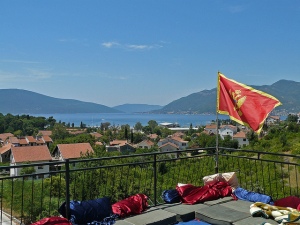 When I hooked up with a small group of lovely folks staying at the hostel in Tivat where I’d been living, I decided to let the ship sail and join in the adventure to the country that is still possibly the biggest anomaly in Europe. So after our final night and meatball party we set off to the once repressive land of the Eagle, a land that hadn’t allowed any of its mammals to breathe the air or influence of any other nation for close to fifty years. Yes, it’s possible that Enver Hoxha was even more paranoid than Stalin. I guess you’d have to be to build, at great expense, close to a million indestructible bunkers (a quarter of the country’s population) for an imagined threat that never came. Never mind about investing in infrastructure such as half decent roads. No wonder many foreigners still regard driving on Albania’s roads as something akin to playing the old arcade game Moon Patrol, having to drive a small tank-like buggy across a lunar landscape filled with craters and mines. Of course nobody was allowed to own private vehicles (or other property) during those times, and the early 90’s saw the dilapidated transport arteries of Albania clogged with mules, bicycles, and horse-drawn carts. These images still exist in most towns now, even if the ubiquitous Mercedes Benz has become king. But we haven’t even set foot in the country yet, and of course the deprivations and oddities of Eastern European Communism are hardly new discoveries.
When I hooked up with a small group of lovely folks staying at the hostel in Tivat where I’d been living, I decided to let the ship sail and join in the adventure to the country that is still possibly the biggest anomaly in Europe. So after our final night and meatball party we set off to the once repressive land of the Eagle, a land that hadn’t allowed any of its mammals to breathe the air or influence of any other nation for close to fifty years. Yes, it’s possible that Enver Hoxha was even more paranoid than Stalin. I guess you’d have to be to build, at great expense, close to a million indestructible bunkers (a quarter of the country’s population) for an imagined threat that never came. Never mind about investing in infrastructure such as half decent roads. No wonder many foreigners still regard driving on Albania’s roads as something akin to playing the old arcade game Moon Patrol, having to drive a small tank-like buggy across a lunar landscape filled with craters and mines. Of course nobody was allowed to own private vehicles (or other property) during those times, and the early 90’s saw the dilapidated transport arteries of Albania clogged with mules, bicycles, and horse-drawn carts. These images still exist in most towns now, even if the ubiquitous Mercedes Benz has become king. But we haven’t even set foot in the country yet, and of course the deprivations and oddities of Eastern European Communism are hardly new discoveries.
Leaving Tivat, the four of us bussed it to Bar, waiting for another connection to the Albanian enclave of Ulcinj on the Montenegrin side of the border. We met a taxi driver at the bus station who offered to take us across the border and into Shkodra for 10 Euros each, not much more than it would have cost us in public transport anyway, so we accepted and jumped in. I did a fairly good job of dozing through the coastal views in between bouts of a fairly simple Serbian conversation with the driver. When we arrived at the border control we hopped out, walked across and jumped into another taxi that our Montenegrin driver had phoned to pick us up, it being easier to share business with a friend on the other side than continually drive back and forth. One tick for Slavic-Illyrian partnerships. You can notice the difference as soon as you cross the border, it felt just like peeling back the clock a notch or two. I liked what I saw actually; a green hilly countryside with dusty looking villages and more diversity on the roads; pedestrians, animals, bicycles, horse drawn carts and vehicles all sharing the concrete.
We arrived at Florian’s guesthouse a short while later where I promptly lay down and shot my consciousness out of the sky (sleep had mostly eluded me the night before) waking just in time for a lovely homemade dinner. Florian and his family were very hospitable and nice, arranging a car for us the next day to take us into the hills and the semi-famous Komani ferry.
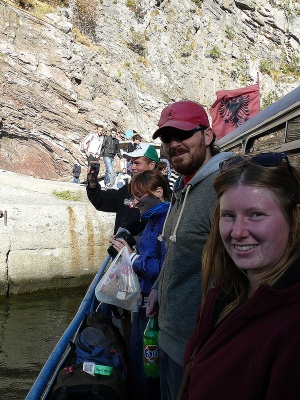 Six am wake up to the cold brrrrr, morning coffee, into car with not enough seats for all of us so backpacks on the roof and comfy half spooning passengers inside, rrrrevrev engine and a slowish crawl out of Shkodra, winding up through the valleys to the Komani dam on the White Drin river, for which the Koman Hydroelectric Power Station was built. There we huddled under the shadows of cold but inspiring canyon sides waiting for the sun to peek over the ranges and our amphibious ferry to escort us up through the folding fjord like gorges to Fierzë. From there it would be a quick hop to the northern metropolis of Bajram Curri (named after the Albanian politician, activist & freedom fighter from Kosovo who shot himself there in 1925) and into the upper valleys of Valbona and Thethi in the Prokletije or Albanian Alps.
Six am wake up to the cold brrrrr, morning coffee, into car with not enough seats for all of us so backpacks on the roof and comfy half spooning passengers inside, rrrrevrev engine and a slowish crawl out of Shkodra, winding up through the valleys to the Komani dam on the White Drin river, for which the Koman Hydroelectric Power Station was built. There we huddled under the shadows of cold but inspiring canyon sides waiting for the sun to peek over the ranges and our amphibious ferry to escort us up through the folding fjord like gorges to Fierzë. From there it would be a quick hop to the northern metropolis of Bajram Curri (named after the Albanian politician, activist & freedom fighter from Kosovo who shot himself there in 1925) and into the upper valleys of Valbona and Thethi in the Prokletije or Albanian Alps.
When our friendly little ferry poked its head around the corner of the river bend and slow motioned towards us it was still in shadow and hard to make out. As it came closer we could see that it was no normal ferry at all but a steel welded hull on top of which an old bus had been dropped. Hence it’s amphibious nature (at least I dreamed of such possibilities). Half an hour later we were aboard, sharing the port and stern of the boat with well dressed chain smoking locals looking like they were heading to an important business conference in the middle of nowhere. Also aboard were two sheep, five water cans and a small handful of foreigners made obvious (like us) by the presence of cameras, video equipment and way too many glassy eyes glued to the scenery all around.
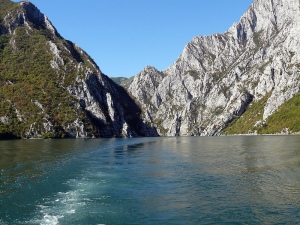 The ferry ride was one of the best I’ve ever been lucky enough to travel on. As the sun warmed us we leisurely putted through the morning sunlit gorges and amazing rock formations on either side of the river, docking briefly at random little points and bays to pick up or drop off smiling locals who would hop off and then disappear around blind corners of wilderness or over small hills into invisible villages. I remember thinking at the time that whilst I could see the geographic relationship between where we were and the not so distant mountains of northern Montenegro, the people here obviously lived more remotely and were more ‘back in the dark ages’ as far as lifestyle and access to various services and technologies was concerned. This was an observation that would come up time and again throughout Albania and is one reason why the country could still be considered to be off the modern European map so to speak. Europe is of course not just a geographic landmass but a term denoting a human continent of sorts, one that spans epochs of conflict and cooperation amongst numerous races and cultures. The great human mash up sweeping in and across the shifting boundaries of civilizations.
The ferry ride was one of the best I’ve ever been lucky enough to travel on. As the sun warmed us we leisurely putted through the morning sunlit gorges and amazing rock formations on either side of the river, docking briefly at random little points and bays to pick up or drop off smiling locals who would hop off and then disappear around blind corners of wilderness or over small hills into invisible villages. I remember thinking at the time that whilst I could see the geographic relationship between where we were and the not so distant mountains of northern Montenegro, the people here obviously lived more remotely and were more ‘back in the dark ages’ as far as lifestyle and access to various services and technologies was concerned. This was an observation that would come up time and again throughout Albania and is one reason why the country could still be considered to be off the modern European map so to speak. Europe is of course not just a geographic landmass but a term denoting a human continent of sorts, one that spans epochs of conflict and cooperation amongst numerous races and cultures. The great human mash up sweeping in and across the shifting boundaries of civilizations.
We arrived in the little ferry port come knockabout building site of Fierzë three hours later amongst a few larger car ferries that didn’t seem to be going anywhere anytime soon, jumped into our first furgon of sorts and bumbled up the road to Bajram Curri. Here we stopped for coffee and asked around about a ride to Valbona. I’d read somewhere that Albania lacked perceptible bus stations and we soon found this out. Luckily people were always friendly and helpful, ushering us first down one street then another to where the last furgon to Valbona was supposed to depart from.
Actually I have no real issues with the lack of singular big bus stations in this country. Every town has a number of places where buses and furgons arrive or depart from, you just need to ask a local or two when you’re there.
After a few minutes standing on a random corner amidst broken conversations with a young girl who spoke decent English we were rescued by an old man yelling in the direction a small mini van just up the road from us. This was the one, apparently, we just had to wait. He was right and as it came swinging around the corner we hopped in to spend the next half hour pleasantly bouncing up and down on the dirt road to the mythic valley of Valbona (it was mythic in my mind at least).
Valbona has a number of guesthouses strewn along the valley and we were lucky enough to find a good one that was also the cheapest in the area as well as being quite a little social hub for locals. About 7€ each per night for a spacious room in the family farmhouse overlooking the valley to the mountain sides. That night we feasted on huge plates of lamb off the bone and potatoes for about 5€, downed a couple of beers and slid into dreamland.
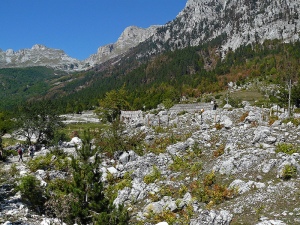 The Valbona valley is a great place to start a hike from. There are numerous trails up and around the various peaks, through the plateaus skirting highland lakes as well as small isolated villages that literally seem to appear out of nowhere with access only by foot or horse. The only problem, I found out later, is that quite a few of them disappear at points into little more than oral memories of locals who’ve been trekking up down and across the region forever. At about midmorning we started a day walk up one side of the valley hoping to find a small village with 2 or 3 buildings dotted on the map, then up to a pass where we figured we’d have a good view of the whole area. After initially walking off the path and scrambling up a scree slope we came to the small village of Kukaj in a meadow like plateau whose sides were hung with Beech and Fir trees, overlooking a number of peaks on the other side of the valley we’d just come from. We’d found the village but weren’t destined to find the pass, though not through any problems with the trail.
The Valbona valley is a great place to start a hike from. There are numerous trails up and around the various peaks, through the plateaus skirting highland lakes as well as small isolated villages that literally seem to appear out of nowhere with access only by foot or horse. The only problem, I found out later, is that quite a few of them disappear at points into little more than oral memories of locals who’ve been trekking up down and across the region forever. At about midmorning we started a day walk up one side of the valley hoping to find a small village with 2 or 3 buildings dotted on the map, then up to a pass where we figured we’d have a good view of the whole area. After initially walking off the path and scrambling up a scree slope we came to the small village of Kukaj in a meadow like plateau whose sides were hung with Beech and Fir trees, overlooking a number of peaks on the other side of the valley we’d just come from. We’d found the village but weren’t destined to find the pass, though not through any problems with the trail.
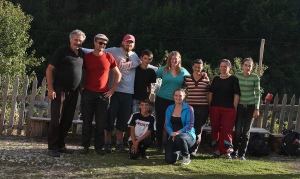 Near the two family village a young boy ran up to us and called us onto his family’s property. ‘C’mon cmon, tea, coffee, hajda!’. So we followed him over to his house to meet his older brother and mother. They gave us tea, coffee and bowls of fresh berries they had growing about the place. A little later on dad woke up and we were invited into the house where beer, raki, green tomatoes and different types of cheese appeared on the table, all homegrown or made (except the beer). Conversation was stunted to say the least but none of us, visitors or locals, seemed to mind. They liked meeting foreigners and for us it was our first experience of Albanian hospitality at its finest. Sometime later we emerged happy and a wee bit foggy headed into the afternoon light, just as the sun was heading over the mountains. Hands were shook, group photos taken and the four of us walked back down the valley just beating the dark.
Near the two family village a young boy ran up to us and called us onto his family’s property. ‘C’mon cmon, tea, coffee, hajda!’. So we followed him over to his house to meet his older brother and mother. They gave us tea, coffee and bowls of fresh berries they had growing about the place. A little later on dad woke up and we were invited into the house where beer, raki, green tomatoes and different types of cheese appeared on the table, all homegrown or made (except the beer). Conversation was stunted to say the least but none of us, visitors or locals, seemed to mind. They liked meeting foreigners and for us it was our first experience of Albanian hospitality at its finest. Sometime later we emerged happy and a wee bit foggy headed into the afternoon light, just as the sun was heading over the mountains. Hands were shook, group photos taken and the four of us walked back down the valley just beating the dark.
Two of the group left the next day so Becca and I chilled out and explored the valley a bit more, deciding to walk over the Valbona pass to Thethi the next day. After being driven by the guesthouse owner’s brother up the gravel riverbed road to the end of the valley, we set off to to do the 15km long, 1km into the sky route. It’s a beautiful walk that takes you through forested areas after the last small village of Rragam, onto a small valleyed plateau where shepherds like to take their flock, scrambling around a small path hugging the rock-face and up to the pass. It’s a great view on either side from the pass, and nice to notice the differences between the two valleys (Valbona has a lot more sheer rock-faces and near vertical scree slopes whereas Thethi is greener, both through the gullies and on the valley floor).
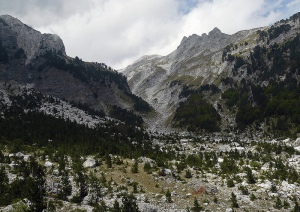 The path took us down on a winding course around rocky outcrops, through scrubby brush and some deeper forest lit by the soft autumn glow of fallen leaves on the forest floor to skimp down an old dirt track to the village of Thethi. I’m glad we didn’t decide to do the return journey the same day as I’m sure we wouldn’t have made it, especially since my heels had developed sizeable blisters by the time we reached Thethi (the curse of old half worn through socks).
The path took us down on a winding course around rocky outcrops, through scrubby brush and some deeper forest lit by the soft autumn glow of fallen leaves on the forest floor to skimp down an old dirt track to the village of Thethi. I’m glad we didn’t decide to do the return journey the same day as I’m sure we wouldn’t have made it, especially since my heels had developed sizeable blisters by the time we reached Thethi (the curse of old half worn through socks).
We found a small guesthouse to stop the night in out the back of a cafe and some next door neighbours who cooked us dinner (there are no shops anywhere near), woke up the next day and started the hike back up after some breaky of local cheese, jam, bread and coffee. That day ended up being one of the more painful days of walking I’ve done, mostly because both my heels were fast turning into fat red welts that rubbed on every up step. Three quarters of the way up we passed a funny little place with three rustic wooden porch like structures complete with table and chairs. Unlike the day before it wasn’t abandoned, having become a bush cafe of sorts with one local man in his tiny hut and a gas stove selling coffee and raki. Go the bush cafe! I desperately needed to give my feet some breathing space so sat down for a raki. Or two, or three, or four. I thought it would numb the pain. And the view back down to Thethi was glorious, getting more vibrant with every glass. It didn’t end up numbing the pain, though, being somewhat like slowed down liquid cocaine, it gave me a pleasant semi stoned sort of hum even though I was still grimacing the rest of the way up.
I found Becca waiting at the pass, the first time I’ve been out-walked by a girl dammit, though I had an excuse of course. We cruised down to Valbona over the next couple of hours and headed back into the guesthouse, picking up a ride from the local furgon driver for the last kilometre or so. I hobbled into the restaurant whilst Becca went back to the room. The first thing I wanted to do was take my boots off, which I did, and when the owner saw me scowling at my feet and pointing to my heels he promptly brought over a bottle of raki and splashed it liberally all over the back half of my feet. OUCH! Fuck, that hurt, though it numbed them after a couple of minutes. I later ate a bowl of sheep’s heart stew from the sheep we saw being spit roasted on long poles the day we’d left. It was one of the heartiest small bowls of broth I’ve ever eaten.
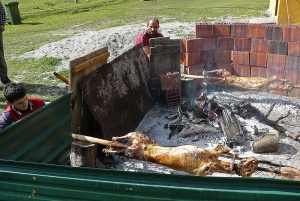 The next day we rested up again, not doing too much besides meandering a bit further down the river that runs through the valley and me experimenting with a few long exposure creek photographs. That and of course eating more large plates of lamb off the bone (yum!).
The next day we rested up again, not doing too much besides meandering a bit further down the river that runs through the valley and me experimenting with a few long exposure creek photographs. That and of course eating more large plates of lamb off the bone (yum!).
Next, the 6am start (you can tell I love early mornings no?) to jump on the daily furgon back to Bajram Curri then onward to Tirana and central Albania.
To be continued (sometime or other) ….
